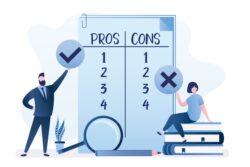It’s considered rare when anyone truly gets what they want in a divorce. But it’s possible to get all that you need by focusing on the most important issues and remaining mindful of a positive, goal-oriented mindset. In a high-conflict divorce, maintaining priorities and remaining positive can be the difference in finding long-term health and happiness.
How to reduce the trauma of high-conflict divorce
Think of high conflict as high drama. Personalities in turmoil tend toward their worst denominator, and people with a domineering or vengeful personality trait will likely be seeking a dramatic, often traumatic, outcome with the ending of their marital story. These types of people will seek to blame, avoid fundamental changes to their lifestyle, and are probably going to project toxic influence upon children.
Mediation is a type of settlement approach for low-conflict divorce that focuses on an amiable, harmonious resolution as its goal. Even a high-conflict divorce hopes for such resolution. With high-conflict divorce, there are approaches and techniques a family law court can use to reduce the effects of this traumatic environment.
According to Bill Eddy, a lawyer and therapist, and a Senior Family Mediator at the National Conflict Resolution Center in San Diego, both parents might be ordered into counseling to learn four big skills:
- managed emotions
- flexible thinking
- moderate behavior
- checking themselves, “which they will also teach to their children.”
By focusing the family’s energy on change, a new, healthy path can be created.
In addition, a Guardian Ad Litem (GAL) might be appointed by a court to provide an objective report on the family’s dynamic, with parents being assessed on various criteria. According to the University of Arkansas Law Review article “The Guardian Ad Litem – Custody and Conflict Cases,” GALs are “investigators, champions, and referees” within family courts that “evolve as more of a social service agency than a separate constitutional branch of government charged with the issuance of judgments.”
If there are domestic-violence allegations or restraining orders, courts proceed deliberately to maintain safety as a priority. The key is to keep the children and their safe future as the priority, while staying positive about outcomes.

Protecting family members is a priority of high-conflict resolution
With a high-conflict experience, simmering emotions might become volcanic very quickly, and trauma is a by-product of this dangerous, volatile environment. With divorce, the profound stress of a person’s home and family being threatened makes for added emotional explosiveness.
Domestic Violence Protection Orders (DVPOs) and Temporary Restraining Orders (TROs) are ways the court can step in to support the family, prevent emotional trauma, and protect against threats. The court’s priority will be to keep the mother and children safe – or the father, if it’s a unique parenting domicile.
For a Licensed Marriage and Family Therapist (LMFT), a typical approach will be to understand the family dynamic and the source of the conflict or “triggers.” According to the Synergetic Play Therapy Institute, “Divorce is often painted as a traumatizing experience, but what it looks like through the perspective of a child varies greatly. Working with high conflict divorce requires recognizing this deviation. It also requires a neutrality and a focus on what matters most: healing the child.” Healing may mean changing perspectives to see things differently, allowing the conflict to become more understandable and manageable.
Dialectical (DBT), Cognitive (DBT), and “Play” therapy and counseling are valuable tools for imagining and creating pathways of healing and protection within a family-in-conflict dynamic. And court-ordered classes like “Regulating Aggression,” or “Co-Parenting in Peace” can surprisingly be a conduit for joy by providing families a balanced, safe engagement with difficult challenges.

These tools help find compromise in high-conflict cases
A large amount of the drama in a high-conflict divorce case is found within verbal or digital-media exchanges tainted by hatred and anger. “I’ll take your children,” or “You’ll get nothing,” or “Everyone hates you” is common language when the toxicity of a broken marriage is allowed its hurtful megaphone. Most of these threats never gain traction, and the court seeks to stop this behavior. Much of what family law will attempt to repair or refocus is the ability of the parents to have meaningful, rational communication, and there are several methods for achieving this amiable goal.
One such method is court-ordered written communication. Our Family Wizard is a leading consumer-app “helping healthy families thrive since 2001” with a vision for “Empowering Amicable Parenting” as a benefit to usage of and engagement with its product. The app offers a comprehensive approach to managing co-parent responsibilities and duties – everything from scheduling extracurricular activities to itemizing parenting calendars.
And these types of apps and websites also offer a palette for collaboration, whereby contrasting personalities can engage with a topic and find middle ground. Think of it as the court’s way of forcing compromise, with a written record of these efforts to create harmony. After all, just like mediation in low-conflict-divorce, there must be some middle-ground to operate from or settlement will be based solely on the court’s ability to assess and manage a broken-marriage contract.
Particularly with divorce involving children, a GAL will seek this moderation as a sign of potential for a family dynamic to be healthy and sustainable. Less high conflict, more positive communication equals positive divorce outcomes.

Focus on the children to ease conflict
Long-term health and happiness should be the goal for any civil dispute. With a dissolution of marriage, or divorce, evidence shows that the lower the conflict, the lower the trauma – and the greater likelihood for a foundation of trust, respect, and even, yes, happiness.
Managing and overcoming conflict in divorce is possible with a focus on priorities – usually the children and their future – while creating positively aligned goals and results for long-term happiness. It’s the genuine intent of the court to allow the parents to collaborate on the most important issues and remain mindful of a positive, goal-oriented mindset. Court orders also make it mandatory for parents to do this.
Focus on priorities. Reduce conflict. Create positivity. Remove trauma. Be happy.






